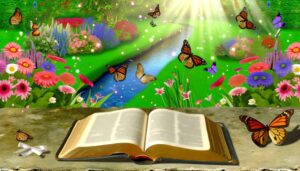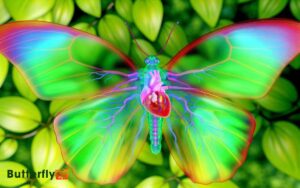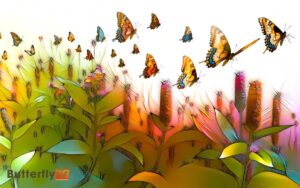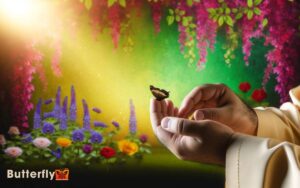How To Say Butterfly In French? Papillon!
To say butterfly in French, use the word ‘papillon.’ Pronounce it as ‘pa-pee-yon.’ Make sure to stress each syllable correctly and pay attention to the nasal sound at the end.
In French culture, ‘papillon‘ symbolizes transformation and beauty. It’s not just used to describe the insect; for instance, ‘nœud papillon‘ means bow tie.
Butterflies also appear frequently in French art and folklore, symbolizing personal metamorphosis.
If you want to explore more about how butterflies influence French language and culture, there’s plenty to discover.
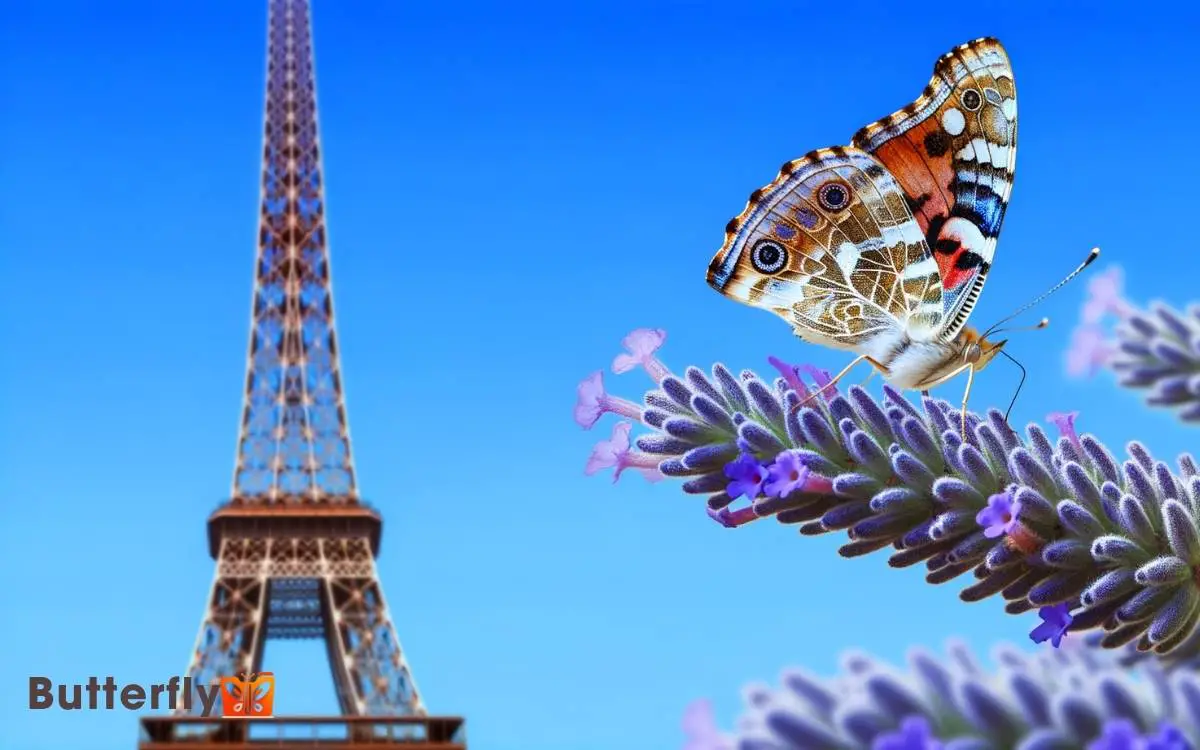
Key Takeaways
The French Word for Butterfly
In French, the word for butterfly is ‘papillon.’ This term captures the essence of the creature’s delicate, fluttering nature. Derived from the Latin ‘papilio,’ it reflects the same root as the English term.
When you use ‘papillon,’ you’re not just naming an insect; you’re embracing a rich linguistic history.
For example, in technological innovation, ‘Papillon’ is also used metaphorically to describe software that adapts and evolves. By understanding this word, you gain insight into broader cultural contexts.
If you’re developing a product, consider how the symbolism of ‘papillon’ transformation and beauty could enhance your branding.
Utilizing ‘papillon’ in your lexicon isn’t merely adding a translation; it’s integrating a nuanced, sophisticated concept that resonates across various fields.
Pronouncing ‘Papillon’ Correctly
Mastering the pronunciation of ‘papillon‘ requires attention to the nuances of French phonetics. You need to focus on each syllable’s distinct sound.
Start with the ‘pa’, which sounds like ‘pah’ a short, crisp syllable. The ‘pi’ is pronounced ‘pee’, but softer, almost like ‘pee-yoh’. Finally, ‘llon’ merges smoothly into ‘yon’, where the ‘ll’ has a soft, almost silent quality, and the ‘on’ adopts a nasal tone.
Guarantee your intonation flows naturally, without abrupt breaks. Practice by breaking down the word into its components, then blend them seamlessly.
Precision in each element will greatly enhance your pronunciation, making your ‘papillon’ sound authentically French.
This methodical approach ensures you grasp the subtleties, providing a foundation for mastering more complex French words.
Phonetic Breakdown
When breaking down the pronunciation of ‘papillon‘, focus on each syllable: [pa-pee-yon]. Pay attention to the nasal ‘on’ sound at the end, which is essential for accurate pronunciation.
Common mistakes include mispronouncing the nasal sound or stressing the wrong syllable, so practice with native audio examples.
Pronunciation Guide
To properly pronounce ‘papillon,’ which means butterfly in French, focus on breaking it down phonetically as ‘pa-pee-yon.’ The first syllable ‘pa’ should be short and crisp. The second part, ‘pee,’ requires a long ‘ee’ sound.
Finally, ‘yon’ blends the ‘y’ sound with a nasalized ‘on.’ Here’s a detailed breakdown:
| Syllable | Phonetic | Explanation |
|---|---|---|
| pa | /pa/ | Short, sharp ‘a’ sound |
| pee | /pi/ | Long ‘ee’ sound |
| yon | /jɔ̃/ | Nasal ‘on’ with a ‘y’ blend |
Practicing each segment separately helps you master the full pronunciation. Pay attention to the nasalization in ‘yon’ which is a signature sound in French. With these steps, you’ll confidently say ‘papillon’ like a native speaker.
Common Mistakes
Many learners struggle with the nasal ‘on’ in ‘yon,’ often pronouncing it too sharply or without the proper nasalization.
To master this, focus on a soft, resonant sound produced in the nasal cavity. It’s important to avoid over-articulating the ‘n’ sound. Visualize the airflow through your nose, not your mouth.
For example, in ‘papillon,’ the ‘on’ should resemble the soft, nasal sound found in the French word ‘non,’ not a hard ‘n’ as in English ‘on.’
Another common mistake is mispronouncing the ‘i’ in ‘papi.’ Make sure it’s a short, crisp ‘ee’ sound, avoiding any diphthong. Practicing with native audio can greatly refine your pronunciation, leading to a more authentic and fluid French speech.
Common Uses of ‘Papillon’
In French, ‘papillon’ is commonly used not only to refer to the butterfly itself but also in various contexts such as fashion, literature, and everyday expressions.
In fashion, ‘nœud papillon‘ means bow tie, adding a delicate touch to formal attire.
Literature often employs ‘papillon’ to symbolize transformation and beauty, enriching narratives with metaphorical depth.
In everyday expressions, you might hear ‘avoir des papillons dans le ventre,’ describing the sensation of nervous excitement.
Additionally, the word ‘papillonne‘ is used to describe someone who flits from one activity to another without settling.
These diverse usages of ‘papillon’ highlight its versatility in the French language, making it a term that transcends its literal meaning.
Butterfly Symbolism in France
You’ll find that butterflies hold significant historical and cultural importance throughout France. Artists frequently incorporate butterflies in their work, symbolizing transformation and beauty, as seen in the Art Nouveau movement.
French folklore and legends often portray butterflies as messengers of the soul, adding a mystical dimension to their symbolism.
Historical Cultural Significance
Exploring butterfly symbolism in France reveals its deep-rooted connections to transformation, beauty, and the fleeting nature of life. Historically, butterflies have symbolized the human soul, echoing ancient Greek beliefs.
In France, this symbolism evolved, representing personal metamorphosis and enlightenment.
During the Renaissance, butterflies in French literature and philosophy illustrated transient beauty and the ephemerality of existence. The term ‘papillon’ itself evokes this delicate balance.
In French folklore, butterflies were often seen as messengers between the earthly and spiritual domains. By understanding this cultural significance, you’ll appreciate how deeply ingrained butterflies are in the French mindset, influencing societal views on change, beauty, and mortality.
This historical perspective enriches your grasp of the butterfly’s multifaceted role in French culture.
Artistic Representations
French artists have long celebrated the butterfly’s symbolism, infusing their works with themes of transformation and ephemeral beauty.
You’ll find this in the delicate brushstrokes of impressionist painters like Claude Monet, who captured fleeting moments in nature.
Symbolist artists, such as Odilon Redon, often depicted butterflies to explore metaphysical themes and the soul’s journey.
In modern design, butterflies appear in haute couture, with designers like Jean Paul Gaultier integrating intricate butterfly motifs into avant-garde fashion.
The butterfly’s form also inspires contemporary sculptors, creating kinetic sculptures that mimic its graceful flight.
Folklore and Legends
Delving into French folklore, butterflies often symbolize the souls of the departed, believed to be messengers between the living and the afterlife. In many regions, seeing a butterfly flutter by your home signifies a visit from a loved one who’s passed away.
This belief imbues butterflies with a sacred reverence, making their appearance a profound moment of connection.
For instance, during All Saints’ Day, known as La Toussaint, you might notice an increase in butterfly imagery. The delicate creature’s ephemeral nature mirrors the fleeting essence of life itself.
Embrace this symbolism to innovate your understanding of metamorphosis, seeing it not just as a biological process but as a spiritual journey. Recognize the butterfly as a bridge between worlds. Allow its transformation to inspire personal growth, encouraging you to shed old layers and emerge renewed. By viewing life’s changes through this lens, you can find beauty in each phase of your own evolution. If you’re looking for a creative way to honor this symbolism, exploring how to draw a butterfly tattoo can be a meaningful artistic expression.
In Literature and Poetry
In literature and poetry, the word ‘papillon‘ often flutters through verses, symbolizing transformation, beauty, and the ephemeral nature of life. You’ll find it in the works of Victor Hugo, where ‘papillon’ embodies fleeting moments of joy and innocence.
In contemporary poetry, ‘papillon’ frequently analogizes metamorphosis, reflecting personal growth and change. For instance, in the poems of Yves Bonnefoy, the butterfly’s delicate wings mirror life’s transient beauty.
By employing ‘papillon,’ poets and writers harness the butterfly’s delicate imagery to evoke deeper emotional responses.
This word doesn’t just describe an insect; it conjures a world of metaphorical richness, allowing you to explore themes of impermanence and renewal with nuanced elegance.
Famous French Butterflies
As you explore the symbolic richness of ‘papillon‘ in literature, you’ll also find that France is home to several famous butterfly species, each with its own unique characteristics and ecological significance.
For instance,
- The Apollo butterfly (Parnassius apollo) is renowned for its striking white wings adorned with red and black spots, making it a favorite among entomologists.
- The Large Blue (Phengaris arion) is another remarkable species, celebrated for its fascinating lifecycle involving ant colonies.
- Finally, the Provençal Fritillary (Melitaea deione) captures attention with its vibrant orange and black patterns.
These butterflies not only contribute to biodiversity but also play critical roles in pollination, demonstrating the intricate connections within ecosystems. Their presence enriches France’s natural heritage.
Butterfly Species in France
When you explore butterfly species in France, you’ll find common varieties like the Painted Lady and the Swallowtail.
However, some native species, such as the Apollo butterfly, face endangerment due to habitat loss.
France has implemented various conservation efforts, including habitat restoration and legal protections, to preserve these delicate creatures.
Common French Butterflies
France boasts a diverse array of butterfly species, with the Swallowtail (Papilio machaon) and the Adonis Blue (Polyommatus bellargus) being some of the most frequently observed.
The Swallowtail, known for its striking yellow and black wing patterns, often inhabits open landscapes like meadows and gardens. You’ll notice its unique tail-like extensions on the hindwings, making it easily identifiable.
Meanwhile, the Adonis Blue captivates with its vibrant azure hue, typically seen in chalk grasslands. This species displays sexual dimorphism, with males sporting brighter blue wings compared to the females’ brownish coloration.
Observing these butterflies in their natural habitats provides insight into France’s rich biodiversity and offers opportunities for innovative ecological studies.
Endangered Native Species
Several butterfly species native to France face endangerment due to habitat loss, climate change, and pollution.
The Apollo butterfly (Parnassius apollo), once widespread, now struggles as alpine meadows shrink. The Iberian Sooty Copper (Lycaena bleusei) faces similar challenges with its wetland habitats disappearing. Urban expansion and pesticide use further threaten these delicate insects.
You can observe the rapid decline of the Scarce Large Blue (Phengaris teleius), a species reliant on specific ant populations for survival. Their symbiotic relationship makes them particularly vulnerable to environmental changes.
France’s natural heritage is at risk, emphasizing the urgent need for innovative solutions. Protecting these species requires understanding their ecological roles and the intricate balance they maintain in their habitats.
Butterfly Conservation Efforts
Efforts to conserve butterfly species in France hinge on habitat restoration, targeted breeding programs, and stringent regulatory measures.
You can see how innovative approaches are making a difference. Habitat restoration focuses on planting native flora and creating butterfly corridors.
Targeted breeding programs guarantee genetic diversity and population resilience. Regulatory measures safeguard key habitats from development and pollution.
Here’s a snapshot of ongoing efforts:
| Initiative | Description | Impact |
|---|---|---|
| Habitat Restoration | Planting native flora | Increased butterfly populations |
| Targeted Breeding | Genetic diversity and resilience | Stronger species survival |
| Regulatory Measures | Protection from development and pollution | Preserved natural habitats |
These measures are essential for sustaining butterfly biodiversity in France.
Cultural Significance of Butterflies
Butterflies hold a profound place in French culture, symbolizing transformation, freedom, and the ephemeral nature of life. They’re prominently featured in French literature and art, often representing metamorphosis and fleeting beauty.
For instance, in Victor Hugo’s ‘Les Misérables,’ butterflies appear as symbols of innocence and change. French gardens, like Jardin des Tuileries, showcase vibrant butterfly species, reinforcing their aesthetic and symbolic values.
Designers often draw inspiration from butterfly motifs, creating fashion that captures their delicate allure and transformative essence.
By understanding these cultural nuances, you can appreciate how the butterfly, or ‘papillon,’ transcends mere biological interest, embodying deeper, innovative themes within French heritage and contemporary expression.
Butterfly-related Phrases
Understanding the cultural significance of butterflies in France enriches your grasp of butterfly-related phrases, such as the enchanting ‘avoir des papillons dans le ventre,’ which vividly describes the sensation of feeling nervous or excited.
This phrase translates to ‘having butterflies in the stomach‘ and is commonly used in romantic or anxious contexts. Another intriguing phrase is ‘voler de ses propres ailes,’ meaning ‘to fly with one’s own wings,’ symbolizing independence and self-reliance.
These expressions reflect the butterfly’s symbolic association with transformation and freedom.
By incorporating these phrases into your vocabulary, you not only enhance your linguistic skills but also gain a deeper understanding of French idiomatic expressions, thereby enriching your cultural and conversational repertoire.
Learning Through Songs
Listening to French songs about butterflies can be a delightful and effective method to enhance your language skills while immersing yourself in the culture. Music stimulates your brain, making vocabulary retention more natural and enjoyable.
Songs such as ‘Le Papillon’ by Sanseverino not only introduce you to the word ‘papillon’ but also embed it within a cultural context.
- Emotional Connection: Music evokes feelings, helping words stick.
- Repetition: Lyrics repeat, reinforcing vocabulary.
- Cultural Insight: Songs provide cultural nuances and idioms.
- Pronunciation Practice: Singing along improves accent and fluency.
Practice Makes Perfect
When you consistently practice saying ‘papillon,’ your pronunciation and fluency in French will significantly improve. Regular repetition is key to mastering the nuances of this beautiful language.
Break down the word into its syllables: pa-pi-llon. Emphasize the nasal sound at the end, which is essential in French pronunciation.
| Practice Activity | Description |
|---|---|
| Phonetic Exercises | Break down ‘papillon’ into manageable sounds |
| Listening to Natives | Engage with French media to hear correct usage |
| Recording Yourself | Record and compare your pronunciation |
| Repetition Drills | Say ‘papillon’ multiple times throughout the day |
Conclusion
By mastering ‘papillon,’ you’re not just learning a word; you’re opening a window to French culture. Envision each use as a butterfly fluttering through your conversations, adding color and nuance.
Practice diligently, incorporate it in phrases, and even sing it in songs. With each attempt, you’ll get closer to speaking French fluently.
Remember, language is a dance, and ‘papillon’ is your graceful step into a richer vocabulary. Keep practicing, and let your words soar.



